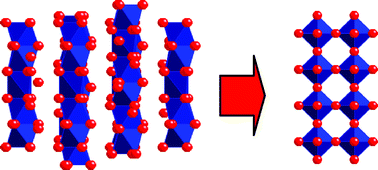In this paper we report the successful incorporation of silicon into SrMO3 (M = Co, Mn) leading to a structural change from a hexagonal to a cubic perovskite. For M = Co, the cubic phase was observed for low doping levels (3%), and these doped phases showed very high conductivities (up to ≈350 Scm−1 at room temperature). However, annealing studies at intermediate temperatures (700–800 °C), indicated that the cubic phase was metastable with a gradual transformation to a hexagonal cell on annealing. Further work showed that co-doping with Fe resulted in improved stability of the cubic phase; a composition SrCo0.85Fe0.1Si0.05O3−y displayed good stability at intermediate temperatures and a high conductivity (≈150 Scm−1 at room temperature). For M = Mn, the work showed that higher substitution levels were required to form the cubic perovskite (≈15% Si doping), although in these cases the phases were shown to be stable to annealing at intermediate temperatures. Conductivity measurements again showed an enhancement in the conductivity on Si doping, although the conductivities were lower (≈0.3–14 Scm−1 in the range 20–800 °C) than the cobalt containing systems. The conductivities of both systems suggest potential for use as cathode materials in solid oxide fuel cells.

You have access to this article
 Please wait while we load your content...
Something went wrong. Try again?
Please wait while we load your content...
Something went wrong. Try again?


 Please wait while we load your content...
Please wait while we load your content...